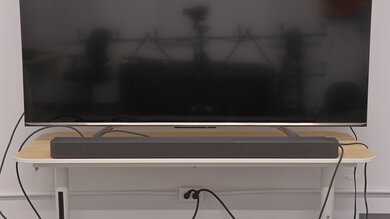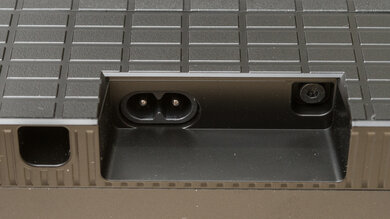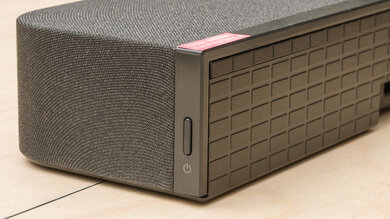The Sony BRAVIA Theater Bar 8 is the smaller sibling of the premium Sony BRAVIA Theater Bar 9. This standalone soundbar packs plenty of audio format compatibility into a sleek package. If you want an easy all-in-one solution without too much adjustment needed, it's worth a look. We tested the soundbar as a standalone, but you can also add satellites and a sub for a greater surround experience. So, can the 5.0.2 soundbar fill out a room without a sub and satellites?
Our Verdict
The Sony BRAVIA Theater Bar 8 is decent for mixed usage. While the sound controls are somewhat limited, you get a room calibration and a handful of mode selections like 'Sound Field' to improve its immersive quality. It provides support for 4k @ 120Hz, which is great for gaming and sports, although if you have older devices, there's no optical connectivity. You can watch your movies and shows and expect support for the majority of formats like Dolby Atmos and DTS:X without a hitch. However, the overall sound performance is fairly jack-of-all-trades, but a master of none, meaning your audio is a bit immersive but not very wide or tall. Besides that, it looks good and is well-built with a reliable app.
-
Excellent audio format support.
-
Clear dialogue.
-
4k @ 120Hz passthrough.
-
Soundstage isn't very wide.
-
Dolby Atmos height isn't very tall.
-
Limited sound enhancement features.
The Sony BRAVIA Theater Bar 8 is good for TV shows and dialogue-heavy content. Its discrete center channel supplies clear dialogue, while the stereo sound is decent. The soundbar has room calibration and a 'Voice' mode to enhance speech, although it lacks more extensive user EQ. While latency is present, you can use the app's A/V Sync to adjust it.
-
Excellent audio format support.
-
Clear dialogue.
-
Limited sound enhancement features.
The Sony BRAVIA Theater Bar 8 is decent for listening to music. It has a somewhat balanced frequency response, which leans a bit bright and mid-rangey. You don't get a separate EQ, but the bar calibrates to the room, and there are a handful of listening modes to tweak its sound, which is otherwise a bit boxy with the default 'Sound Field' function enabled. The soundstage isn't exceptionally wide, which is expected from a soundbar without satellites. With lower-quality audio files, the digital signal processor DSEE Ultimate can upscale the lossy formats. It gets loud enough to fill a room, but at high volumes, it introduces a bit of distortion, and the bass can compress, causing an unnatural pumping effect.
-
Excellent audio format support.
-
Compatible with Bluetooth, AirPlay 2, and Spotify Connect.
-
Soundstage isn't very wide.
-
Limited sound enhancement features.
The Sony BRAVIA Theater Bar 8 is alright for watching movies. On its own, the soundbar can't quite lend a fully immersive and dimensional viewing experience, though you can add satellites and a sub later for a better surround experience. It supports a lot of formats, including object-based Dolby Atmos via its eARC connection. While the dialogue is fairly clear, the soundstage isn't especially wide, and it tracks a bit sloppily. The up-firing speakers seem to create height, but the sound lands in front of you. For its size, it's a little rumbly, but the side-firing speakers aren't very balanced and can hurt the intelligibility of dialogue. The room calibration feature is useful, as is the selection of listening modes like 'Sound Field,' but you don't get a dedicated EQ.
-
Excellent audio format support.
-
Clear dialogue.
-
Soundstage isn't very wide.
-
Dolby Atmos height isn't very tall.
- 7.1 Mixed Usage
- 7.7 Dialogue/TV Shows
- 7.0 Music
- 6.8 Movies
-
Updated Oct 18, 2024:
The Surround 5.1 section has been updated to mention the Sony BRAVIA Theater Bar 9 with Speakers + Bass Module.
- Updated Oct 01, 2024: This review's Updated Aug 21, 2024: Review published.
- Updated Aug 14, 2024: Early access published.
- Updated Aug 08, 2024: Our testers have started testing this product.
- Updated Jul 26, 2024: The product has arrived in our lab, and our testers will start evaluating it soon.
- Updated Jul 23, 2024: We've purchased the product and are waiting for it to arrive in our lab.
Differences Between Sizes And Variants
The Sony BRAVIA Theater Bar 8 can be bought as a standalone in a single color, 'Black.' You can see the label for our unit here. The soundbar is also compatible with satellites and subwoofers sold separately. If you come across another variant of this soundbar, let us know in the comments, and we'll update our review.
Compared To Other Soundbars
The Sony Theater Bar 8 is the manufacturer's mid-tier standalone from 2024. It has two fewer speakers than the Sony BRAVIA Theater Bar 9 and is roughly eight inches narrower. Their looks and features are very similar, so for many, it'll depend on your budget and how tight your space is. However, the BRAVIA Theater Bar 9 is a little more immersive with a slightly bigger soundstage.
In the realm of standalone bars, the Bose Smart Ultra Soundbar offers a bit more of an immersive surround sound and Dolby Atmos experience. However, it lacks DTS support and HDMI passthrough, which is more appealing to those with extensive Blu-ray collections and gamers. Unlike the Sony Theater Bar 8, the Bose soundbar features voice assistants for integrating your smart home tech.
For more recommendations, take a look at the best all-in-one soundbar and the best small soundbars for tight spaces, and for the most immersive surround sound experience, check out the best Dolby Atmos soundbars.
The Sonos Arc provides a better stereo soundstage and a bit more immersive Dolby Atmos height than the Sony BRAVIA Theater Bar 8, allowing you to pinpoint a sound's location better. You have more control over the EQ with the Sonos, but it's harder to get a neutral sound than with the Sony, despite the Sony lacking EQ besides bass control. However, the Sonos bar compresses much less at high volumes, which helps with clarity. Plus, if you have other Sonos speakers in the ecosystem, you can use them all wirelessly via the app. The Sony BRAVIA Theater Bar 8 is better suited for dialogue, with a more balanced center channel. If you watch content with DTS:X, then only the Sony supports the format. The Sony also sports HDMI In and eARC and allows for 4K @ 120Hz passthrough, whereas the Sonos only has eArc and Optical.
The Sony BRAVIA Theater Bar 9 is a bit better than the Sony BRAVIA Theater Bar 8. It has a more immersive sound, thanks to its two extra R/L speakers, wider soundstage, and better-balanced side-firing speakers. However, it's not substantially better. Both soundbars have mostly the same features, like 4k @ 120Hz passthrough, extensive Dolby Atmos and DTS:X support, and good build quality.
The Bose Smart Ultra Soundbar is a bit more immersive than the Sony BRAVIA Theater Bar 8, with a wider soundstage and a slightly higher Dolby Atmos height. Both are fairly bright soundbars with limited sound enhancements besides room calibration and a handful of listening modes. They both reproduce clear dialogue, too. If you're looking for smart home integration, only the Bose offers voice assistance. The Sony offers a bit more audio format support, such as DTS:X, and includes an HDMI In port in addition to eARC. Plus, you can achieve 4k @ 120Hz via passthrough only with the Sony. If you have older devices, the Bose includes Optical, alongside eARC.
For most people, the Klipsch Flexus Core 200 is better than the Sony BRAVIA Theater Bar 8. Thanks to the Klispch's well-balanced sound profile, bigger soundstage, and greater selection of sound enhancement tools, it works better for a variety of usages. On the other hand, the Sony supports more formats like DTS and DTS:X, which is more common for Blu-Rays. It also has HDMI 2.1 passthrough, and the Klipsch doesn't, which may be more useful for gaming.
The Sony BRAVIA Theater Bar 8 is better than the Sony HT-X8500. Its soundstage is wider with a bit more thump. Dialogue is considerably clearer, thanks to the dedicated center channels on the BRAVIA Theater Bar 8, and overall, it sounds less boxy than the HT-X8500. While both support most of the same audio formats, if you're a gamer, the BRAVIA Theater Bar 8 boasts 4k @ 120Hz support, while the HT-X8500 tops out at 60Hz passthrough.
Test Results
The Sony Theater Bar 8 looks like a smaller version of the Sony BRAVIA Theater Bar 9. Both soundbars are low and wide, predominantly made of plastic, and covered in fabric. The bottom right side has two LED indicators.
The Sony HT A8000 doesn't come with a separate subwoofer. However, it houses four subwoofers within the bar. You can also purchase one of its compatible subwoofers, the Sony SA-SW3 or SA-SW5.
The Sony HTA8000 doesn't include any satellites, but you can add the Sony SA-RS5 or the SA-RS3S separately.
The Sony BRAVIA Theater Bar 8 is quite wide; even though it's smaller than the Sony BRAVIA Theater Bar 9, it still won't fit between the legs of a 65-inch TV. That said, it's not a tall soundbar, so the bar won't block your view unless there's no space between the screen and the table.
The Sony BRAVIA Theater Bar 8 is well-built. The bar's plastic construction is weighty, and the top, front, and sides are covered in fabric. However, the fabric can collect dust and hair, which can be hard to clean. Its bottom and back are plastic with a physical power button on the back right-hand side. Alongside the Sony BRAVIA Theater Bar 9, it's a departure from the manufacturer's other designs, like the metal-grilled Sony HT-A5000.
The Sony BRAVIA Theater Bar 8's stereo frequency response is decent. We tested it with 'Sound Field' enabled, which makes instruments take up more space and come across as more accurately placed in the stereo field, though it's still a bit difficult to track them. The bar tends toward a brighter voicing due to a lack of an outboard full-size subwoofer, which works well for dialogue-heavy media, like reality TV and old Hollywood movies. However, the bass sounds fuller if you turn off 'Sound Field,' but unfortunately, disabling 'Sound Field' dulls details in the treble region.
You only get three settings to adjust the bass ('Min,' 'Mid,' and 'Max') and besides 'Sound Field,' there are only two other sound enhancement modes, 'Night' and 'Voice.' Here's a comparison of the different sound enhancement modes, including 'Sound Field' enabled and 'disabled.' You'll note the prominent bump in the mid-range with the 'Sound Field' function enabled, which can cause a somewhat artificial muddiness to your audio.
You can only adjust the bass between three settings ('Min,' 'Mid,' and 'Max'), and it's set to 'Mid' by default. If you want a better-balanced sound, you can up it to 'Max' (which is what '1' represents, if the default 'Mid' is considered '0'). There aren't any other EQ settings for mids or treble.
The soundbar's stereo soundstage is adequate. Its width reaches a bit past the ends of the bar. The soundstage shifts towards the side you're sitting on if you're not facing it dead center, which gives you the impression of an offset soundstage in other positions. The soundstage struggles a bit to accurately place moving sounds with panning that shifts from one side to the other. Its localization is a bit better with 'Sound Field' enabled, but overall, the soundstage isn't exceptionally immersive. For a wider soundstage and better tracking, check out the Klipsch Flexus Core 200.
The soundbar can get loud enough to fill a large room. At maximum volume, the bar compresses quite a lot in the bass range, which causes a pumping effect. Its app has a dynamic range compression (DRC) function set to 'Auto' by default, which was disabled for this test. Depending on the content, the DRC setting can somewhat control pumping and artifacts caused at high volumes.
The Sony Theater Bar 8 has a dedicated discrete center channel, which is very helpful in separating speech and vocals. The sound is mostly balanced and a bit bright, but clear. At normal listening volumes, it's fairly clean without much harmonic distortion, though at max levels, it can impart a bit of distortion.
You can also use a compatible TV's built-in speakers with the soundbar via the S-Center Out port. Hooking up the TV's speakers to the bar combines the center channel of the soundbar with the TV's speakers also used as the center channel; typically, this doesn't meaningfully improve the sound and can make it duller. Using the soundbar alone tends to yield the best results.
The soundbar's 5.1 surround performance is poor. The side-firing speakers at either end of the bar are designed to simulate a surround sound, but they don't totally replace the surround effect of discrete satellites. Their frequency response is uneven, with disproportionately more mid-bass thump and mid-mid-range, which causes vocal articulation and bright sounds to come across as unclear and lacking detail. Meanwhile, action scenes and music lack a full-bodied sound. However, there is a bit of low-end thump. Unsurprisingly, a soundbar like the Sony BRAVIA Theater Bar 9 with Speakers + Bass Module can convey a more immersive and balanced surround sound than this all-in-one bar.
The soundbar includes two up-firing speakers to give the impression of height by directing the sound toward the ceiling to bounce back down. The resulting effect seems to place the height in front of you without great depth. The speakers' unbalanced frequency response causes bright sounds to come across as shrill and not full, with finer details in dialogue sounding less clear. Subjectively, localization along the sides and across the vertical plane is okay during action scenes, but it tracks less clearly with moving sounds, and they lack depth. Action scenes with low-pitched rumble have a bit of a muddy sound, but you can hear rumble somewhat.
The Sony HT A8000 has a limited set of sound customization. It can automatically calibrate the sound to your room. Besides that, 'Sound Field' optimizes the surround sound feature, although it alters the frequency response, which you have little control over. There are also 'Night' and 'Voice' modes. You can adjust the height of the surround and three different bass strengths, as well. The app also has the brand's proprietary digital signal processor (DSP) called DSEE Ultimate, which upscales lossy formats, but it won't noticeably improve already high-quality media formats.
The soundbar has one full HDMI In port and one eARC port. Their side-by-side location is pretty tight if you have chunky cables. Otherwise, there's a S-Center Out port to connect with compatible TVs. On the underside, there's a USB-A port (shown here) for servicing the soundbar.
The soundbar supports many different audio formats using the eARC port, including Dolby Digital and DTS formats found on streaming and Blu-Rays. Object-based formats like Dolby Atmos are supported, too.
The HDMI In port supports a lot of audio formats. This ranges from Dolby Digital through Dolby Atmos and DTS formats. You can expect the soundbar to playback audio from streaming services and Blu-Rays without issue.
The soundbar's audio latency is unremarkable via the eARC port. You'll want to use the app's A/V Sync function to manually adjust the latency if you notice it's high enough that you're encountering lip-sync mismatch. However, some apps and TVs will compensate for latency, too.
The Sony BRAVIA Theater Bar 8's HDMI In port's latency is sub-par. Across all audio formats, latency is high enough that you'll want to consider using the A/V Sync function in the app if you experience lip-sync issues. Some TVs and apps can also compensate for latency, so your results may differ.
The soundbar supports 4k video passthrough @ 120Hz, which is great for video games and sports. It's also compatible with the variable refresh rate G-SYNC format.
The soundbar supports plenty of wireless connection options, including Apple AirPlay 2, Spotify Connect, and Bluetooth. You can easily pair your phone and play music or control music via the Wi-Fi network connection.
The soundbar's interface consists of two color-coded lights on the bottom right side. A white light means it's using the eARC connection; green is for HDMI In, and blue is for Bluetooth. When you change the volume, the light blinks to show that it has registered. Otherwise, the app gives you more information and feedback about settings.
The accompanying remote is small and covers basic functions like power, volume, and input, alongside different listening modes. As shown here, you'll need the app to access more in-depth features.















